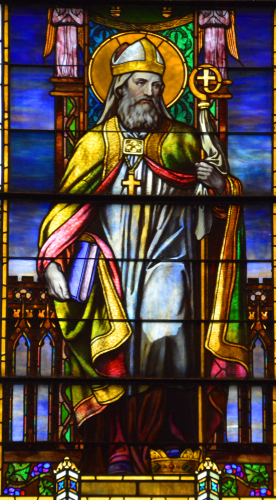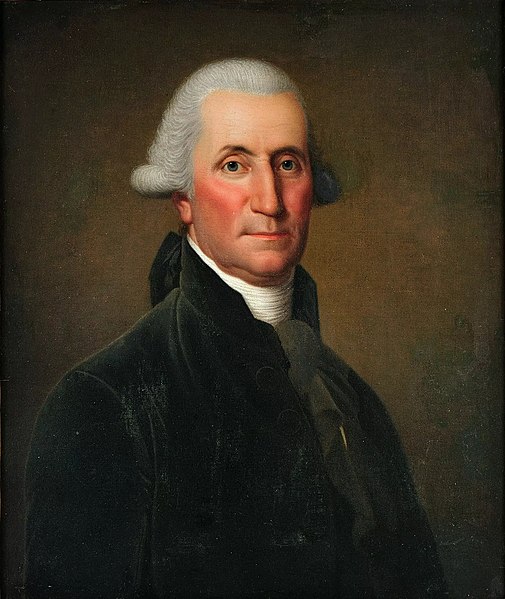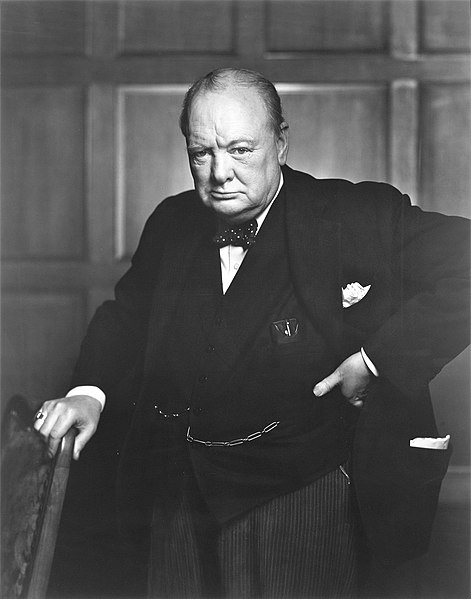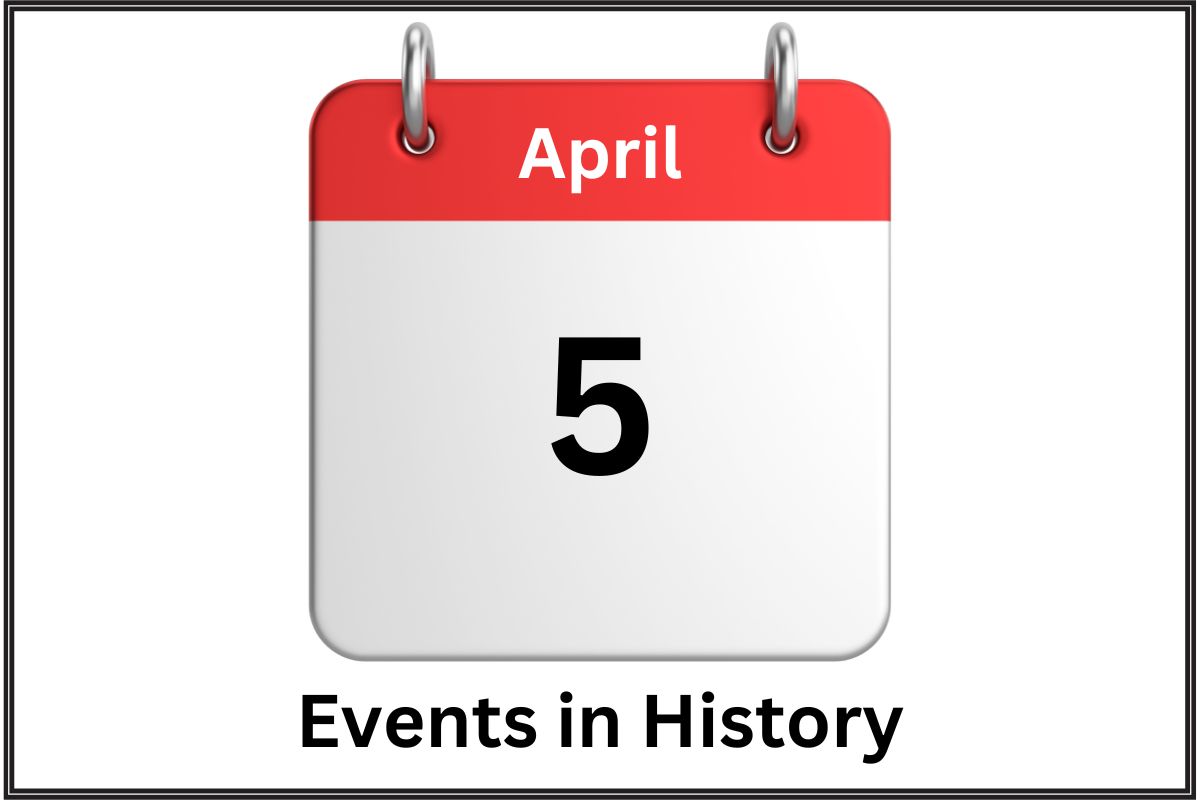April 5th is a day marked by pivotal battles, groundbreaking discoveries, revolutionary innovations, and moments of cultural significance.
From ancient battles that determined the fates of empires to modern technological breakthroughs that redefined how we live, April 5th encapsulates the diversity of human endeavor and achievement.
This article delves into a selection of notable events that occurred on this day, painting a picture of our collective journey through time. Join us as we explore these historical milestones, each contributing a unique thread to the intricate mosaic of our past.
April 5th Events in History
456 – St. Patrick returns to Ireland as a missionary bishop
Saint Patrick, known as the “Apostle of Ireland,” is believed to have lived during the fifth century and is revered as the patron saint of Ireland.
According to tradition, Patrick was kidnapped from Britain by Irish pirates at the age of sixteen and taken as a slave to Ireland. He escaped after six years but returned around 432 AD to convert the Irish to Christianity.
Also Read: April 4 – On this Day in History
By the time of his return in 456 AD, he had established monasteries, churches, and schools, laying the foundations for Christianity across Ireland. His efforts not only Christianized Ireland but also had a lasting impact on Irish culture and history.

1242 – During the Battle of the Ice, Russian forces, led by Alexander Nevsky, repel an invasion attempt by the Teutonic Knights
The Battle of the Ice, also known as the Battle on the Lake Peipus, took place on April 5, 1242, on the frozen surface of Lake Peipus. Prince Alexander Nevsky of Novgorod led the Russian forces against the Teutonic Knights, a German Roman Catholic religious order of crusaders.
Also Read: April 6th Events in History
The battle was a significant defeat for the Knights, effectively halting their eastward expansion into the Slavic lands. Alexander Nevsky’s strategic and military genius was widely celebrated, and he later became a key figure in Russian history, venerated as a saint in the Russian Orthodox Church.
1614 – Pocahontas marries English colonist John Rolfe in Virginia, a significant event in the history of Jamestown and the interaction between Native Americans and English settlers
Pocahontas, the daughter of Powhatan, the paramount chief of a network of tributary tribal nations in the Tsenacommacah, encompassing the Tidewater region of Virginia, married John Rolfe, an English tobacco planter, in a ceremony that took place in Jamestown, Virginia, in 1614.
This marriage is notable for being one of the earliest recorded interracial unions in North American history. It helped to establish a period of peace between the English settlers and the Native American populations.
Pocahontas’s marriage to Rolfe was also significant for the role it played in the tobacco economy in Virginia, as Rolfe introduced a successful strain of tobacco as a cash crop, which became the foundation of the Virginian economy.
1722 – Dutch explorer Jacob Roggeveen discovers Easter Island, a significant event in the history of Pacific exploration
On April 5, 1722, Dutch explorer Jacob Roggeveen landed on a remote island in the Pacific Ocean during his expedition to find Terra Australis, a hypothetical southern continent. He named the island Paasch-Eyland, Dutch for “Easter Island,” because he discovered it on Easter Sunday.
Easter Island, known locally as Rapa Nui, is famous for its nearly 900 monumental statues called moai, created by the early Rapa Nui people.
Roggeveen’s discovery brought the island to the attention of Europeans, marking the beginning of its recorded history and its eventual integration into global culture and science.
1792 – George Washington casts the first presidential veto in U.S. history
On April 5, 1792, George Washington became the first President of the United States to use the presidential veto, an executive power granted by the U.S. Constitution. The bill in question would have apportioned representatives among the U.S. states in a manner Washington believed was unconstitutional.
By vetoing the bill, Washington set a precedent for the use of the veto power, a critical aspect of the checks and balances designed to prevent any single branch of the U.S. government from becoming too powerful.
His action demonstrated the practical application of constitutional law in governing and the importance of the separation of powers within the U.S. political system.

1818 – In the Battle of Maipú, Chilean independence forces led by Bernardo O’Higgins and José de San Martín defeat Spanish royalists, securing Chilean independence
The Battle of Maipú, fought on April 5, 1818, was a pivotal confrontation in the Chilean War of Independence. After a series of conflicts and the previous uncertainty of the revolutionary forces’ success, the battle saw the forces led by Chilean independence leader Bernardo O’Higgins and Argentine General José de San Martín decisively defeat the Spanish royalist forces.
This victory effectively secured Chilean independence from Spanish rule. The triumph at Maipú allowed San Martín to focus on his next campaign, the liberation of Peru, and is celebrated as a key moment in the fight for independence across South America.
1862 – Siege of Yorktown: The American Civil War battle that began the Peninsula Campaign
The Siege of Yorktown, part of the Peninsula Campaign in the American Civil War, began in April 1862 when Union forces under Major General George B. McClellan moved to capture Yorktown, Virginia, from Confederate defenders.
This siege was reminiscent of the last major battle of the American Revolutionary War, also at Yorktown, but this time the town’s strategic significance lay in its location blocking the Union’s path toward the Confederate capital of Richmond. The siege involved trench warfare and delayed the Union advance, reflecting the slow and costly nature of Civil War battles.
Eventually, the Confederates withdrew, allowing Union forces to continue toward Richmond, though the campaign ultimately did not achieve its goal of ending the war swiftly.
1874 – Birkenhead Park, the first publicly funded civic park, opens in Birkenhead, England, influencing the development of parks worldwide
Birkenhead Park, designed by Joseph Paxton, opened on April 5, 1874, in Birkenhead, England, marking the inauguration of the world’s first publicly funded civic park.
Its creation was a response to the industrial revolution’s impact, providing a green sanctuary from urban development and a model for public parks worldwide, including influencing the design of Central Park in New York City.
The park was a pioneering concept that recognized the importance of public green spaces for the well-being of communities, promoting the idea that access to natural beauty should be available to all, regardless of social class.
1879 – Chile declares war on Bolivia and Peru, starting the War of the Pacific
The War of the Pacific began on April 5, 1879, when Chile declared war on Bolivia and Peru, marking the start of a conflict that lasted until 1884. The war was primarily over control of the nitrate-rich Atacama Desert. Nitrate, valuable as a fertilizer and in explosives, became a coveted resource.
The conflict resulted in a significant expansion of Chilean territory at the expense of Bolivia and Peru. Bolivia lost its access to the Pacific Ocean, making it a landlocked country, a situation that has remained a point of contention in Bolivian-Chilean relations to this day. The war significantly impacted the development and boundaries of the involved nations.
1900 – Archaeologists in Knossos, Crete, discover a large cache of clay tablets with hieroglyphic writing in a script they call Linear B
The discovery of clay tablets inscribed with the then-unknown script, Linear B, in 1900 at Knossos on the island of Crete, marked a significant archaeological milestone. British archaeologist Sir Arthur Evans, who led the excavation, initially believed he had uncovered evidence of the ancient Minoan civilization, predating Greek culture.
The tablets, however, remained a mystery until 1952 when British architect Michael Ventris deciphered Linear B, revealing it as an early form of Greek. This discovery confirmed the existence of a sophisticated prehistoric Greek civilization and significantly advanced the understanding of the origins of Greek language and culture.
1923 – Firestone Tire and Rubber Company begins production of inflatable tires
On April 5, 1923, the Firestone Tire and Rubber Company marked a significant advancement in automotive technology by initiating the mass production of inflatable tires. This innovation was pivotal for the automotive industry, enhancing vehicle performance, safety, and comfort.
Inflatable tires replaced the previously used solid rubber tires, offering better shock absorption and traction. The introduction of these tires came at a time when the automobile was becoming increasingly popular and accessible to the American public, thereby playing a crucial role in shaping the future of transportation.
1933 – President Franklin D. Roosevelt signs an executive order creating the Works Progress Administration (WPA) to help combat unemployment in the U.S. during the Great Depression
Executive Order 6102, signed by President Franklin D. Roosevelt on April 5, 1933, was part of the New Deal measures to combat the Great Depression. This order prohibited the hoarding of gold coins, bullion, and gold certificates within the continental United States, compelling citizens to exchange their gold for U.S. currency.
The goal was to halt the banking panic, stabilize the economy, and prevent individuals from avoiding the devaluation of the dollar by holding gold. This move was also intended to give the Federal Reserve more control over the money supply, thereby facilitating economic recovery.
1951 – Julius and Ethel Rosenberg are sentenced to death for espionage in the United States
On April 5, 1951, Ethel and Julius Rosenberg were convicted and sentenced to death for conspiracy to commit espionage, accused of passing atomic bomb secrets to the Soviet Union during World War II.
Their trial and subsequent execution in 1953 were among the most controversial events of the Cold War era, highlighting the intense fear of communism and the political tensions between the U.S. and the Soviet Union.
The Rosenberg case remains a subject of debate regarding the evidence against them, the fairness of their trial, and the severity of their sentences, symbolizing the era’s paranoia and the clash between national security and civil liberties.

1955 – Winston Churchill resigns as Prime Minister of the United Kingdom amid indications of failing health
Winston Churchill, one of the most iconic figures of the 20th century, resigned as Prime Minister of the United Kingdom on April 5, 1955, due to health concerns. Having led Britain through the darkest hours of World War II and again serving as Prime Minister from 1951 to 1955, Churchill’s resignation marked the end of a remarkable career in public service.
His leadership during the war and his contributions to international politics, including his role in establishing the United Nations and warning about the rise of the Soviet Union, left a lasting legacy. His departure from office was a significant moment in British history, signaling the end of an era.
1976 – Billionaire Howard Hughes dies on a plane from Acapulco to Houston, Texas, marking the end of a reclusive life
On April 5, 1976, Howard Hughes, the reclusive billionaire and innovative entrepreneur, died on a plane from Acapulco to Houston. His passing marked the end of a life that had veered from high-profile successes in aviation, filmmaking, and business to decades of seclusion.
Hughes’s legacy, characterized by groundbreaking achievements and eccentric solitude, left a lasting impact on the industries he touched and the public imagination. His death also initiated legal battles over his estate, highlighting the enigmatic nature of his final years.
1991 – An ASA EMB 120 crashes in Brunswick, Georgia, killing all 23 aboard, including U.S. Senator John Tower and astronaut Sonny Carter
On April 5, 1991, Atlantic Southeast Airlines Flight 2311, operating with an Embraer EMB 120 Brasilia, crashed during its approach to Brunswick, Georgia, resulting in the deaths of all 23 people on board. Among the victims were notable individuals such as former Texas Senator John Tower and NASA astronaut Manley “Sonny” Carter Jr.
The crash was attributed to engine failure during the aircraft’s final approach. This tragic event highlighted the importance of stringent safety measures and the need for ongoing improvements in aviation technology and procedures to prevent future accidents.
2010 – Twenty-nine coal miners are killed in an explosion at the Upper Big Branch Mine in West Virginia, one of the worst mining disasters in American history
The explosion at the Upper Big Branch Mine in Montcoal, West Virginia, on April 5, 2010, stands as one of the deadliest mining disasters in U.S. history. The tragedy claimed the lives of 29 coal miners, underscoring the dangerous conditions and safety lapses often present in the mining industry.
Investigations into the incident revealed that violations of safety regulations had contributed to the disaster, leading to a nationwide call for stricter enforcement of mining safety standards and practices. The event had a profound impact on the mining community, prompting reforms aimed at protecting miners’ health and safety.
